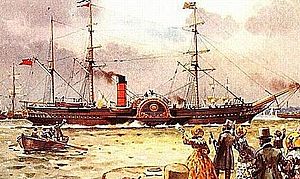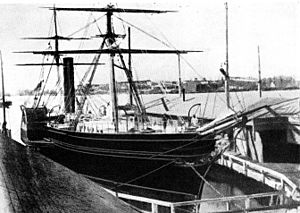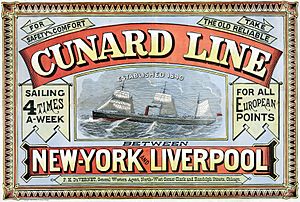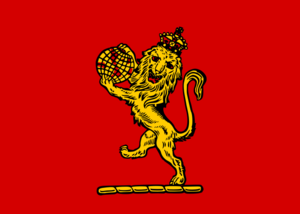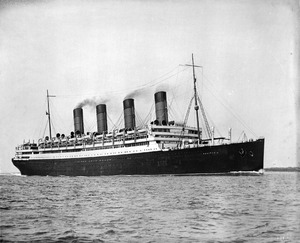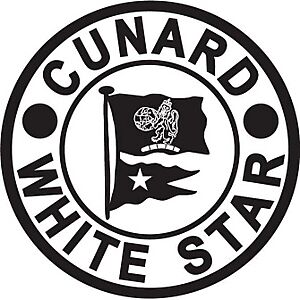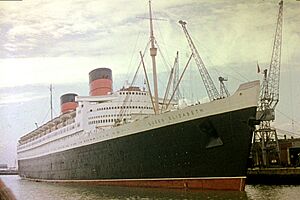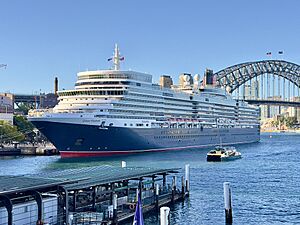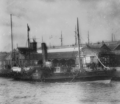Cunard Line facts for kids
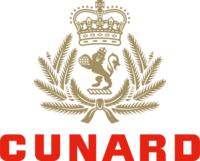 |
|
| Subsidiary | |
| Industry | Shipping, transportation |
| Founded | 1840 (as the British and North American Royal Mail Steam Packet Company) |
| Headquarters | Carnival House, Southampton, United Kingdom |
|
Area served
|
Transatlantic, Mediterranean, Northern Europe, Caribbean and World Cruises. |
|
Key people
|
|
| Products | Transatlantic crossings, world voyages, leisure cruises |
| Parent | Carnival Corporation & plc |
Footnotes / references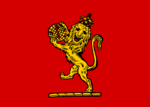 House Flag |
|
The Cunard Line is a famous British shipping company and international cruise line. It is based in Southampton, England. The company is part of Carnival Corporation & plc, a large travel group. Since 2011, Cunard's ships have been registered in Hamilton, Bermuda.
Cunard started in 1839 when Samuel Cunard won a special contract to deliver mail across the Atlantic Ocean using steamships. The next year, he created the British and North American Royal Mail Steam-Packet Company. Their first ships were paddle steamers that sailed between Liverpool, Halifax, and Boston. For many years, Cunard ships were known for being the fastest across the Atlantic, winning the "Blue Riband" award.
Over time, Cunard faced competition from other shipping lines like the White Star Line. To keep up, the company changed its name to the Cunard Steamship Company Ltd in 1879. The British government even helped Cunard build two huge "superliners," the Lusitania and the Mauretania, to stay competitive. Sadly, the Lusitania was sunk during the First World War.
After the war, Cunard moved its main port to Southampton. During the Great Depression, Cunard merged with its rival, the White Star Line, to form Cunard-White Star Line. This allowed them to finish building two more famous ships, the Queen Mary and the Queen Elizabeth. These "Queens" became very important during the Second World War, carrying over two million soldiers.
After the war, Cunard was the biggest passenger line across the Atlantic. However, with the invention of jet airliners in the late 1950s, fewer people traveled by ship. Cunard tried to get into the airline business for a short time but later focused on cruises. The original "Queens" were replaced by the Queen Elizabeth 2 (often called QE2), which could do both transatlantic trips and cruises.
In 1998, Carnival Corporation bought Cunard. In 2004, the QE2 was replaced by the even larger Queen Mary 2 (QM2). Today, Cunard also operates the Queen Victoria, the Queen Elizabeth, and the new Queen Anne. As of 2025, Cunard is the only company that still offers regular passenger trips between Europe and North America.
Contents
History of Cunard Line
Starting the Journey (1840–1850)
Before Cunard, mail was carried across the Atlantic by sailing ships. In 1836, the British government decided to use private companies with steamships instead. Samuel Cunard, a shipowner from Nova Scotia, saw this as a great chance. He worked with Admiral Sir William Edward Parry, a friend and important government official.
In 1839, Cunard won a contract to deliver mail every two weeks between Liverpool, Halifax, and Boston. He didn't own any steamships yet, but he had experience and strong support from Robert Napier, a famous engine builder.
In May 1840, Cunard and his partners formed the British and North American Royal Mail Steam Packet Company. Their first ocean-going ship, the Britannia, sailed on July 4, 1840. It reached Halifax in just over 12 days, which was very fast for the time. Cunard's ships quickly became known for their speed and safety.
Cunard's ships had a special look: red funnels (smokestacks) with black bands and a black top. They also named their ships with names ending in "IA," like Britannia and Acadia.
Safety was very important to Samuel Cunard. He told his captains, "Speed is nothing... safety is all that is required." This focus on safety helped Cunard succeed when other early steamship lines had accidents.
Facing New Challenges (1850–1879)
In the 1850s, new competitors appeared, like the American Collins Line and the British Inman Line. The Collins Line had faster ships at first, winning the "Blue Riband" award for speed. But the Inman Line showed that ships made of iron with screw propellers (instead of paddle wheels) could be profitable.
Cunard responded by building its first iron-hulled paddle steamer, the Persia, in 1855. The Persia helped Cunard regain the Blue Riband. During the Crimean War, Cunard helped the war effort by providing ships.
When Samuel Cunard passed away in 1865, Charles MacIver took over. Cunard was slow to adopt new technologies, and rivals like the White Star Line started building faster, more comfortable ships with new engines and bigger cabins. Cunard eventually caught up, but it was a tough time for the company.
Becoming a Public Company (1879–1934)
To get more money for new ships, the company became a public stock company in 1879, called the Cunard Steamship Company, Ltd. Under its new leader, John Burns, Cunard built modern steel-hulled ships. The Servia in 1881 was the first passenger ship with electric lights throughout.
Cunard continued to build faster ships, like the Umbria and Etruria, which were very fast for their time. They also built the Campania and Lucania, which won the Blue Riband in the 1890s.
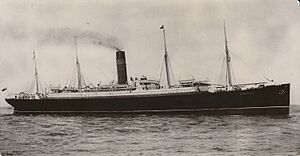
At the start of the 1900s, German ships became very fast. To help Cunard compete, the British government gave the company a large loan and money to build two new "superliners": the Lusitania and the Mauretania. These ships were incredibly fast, with the Mauretania holding the Blue Riband for 20 years!
Cunard also ordered another large ship, the Aquitania. However, the First World War changed everything. The Lusitania was sunk by a German submarine in 1915. After the war, Cunard moved its main operations from Liverpool to Southampton, which was closer to London.
In the 1920s, other countries like Germany, Italy, and France built huge, luxurious liners. Cunard wanted to build its own new superliner, but the Great Depression made it difficult.
Joining Forces with White Star (1934–1949)
By 1934, both Cunard and the White Star Line were struggling financially. The British government offered Cunard money to finish its new superliner, known as "Hull Number 534," but only if Cunard merged with White Star.
So, on May 10, 1934, the two famous rivals joined to form Cunard-White Star Limited. Cunard owned most of the new company. Many older ships from both lines were sold for scrap. Hull Number 534 was finally finished and named the Queen Mary. She was a magnificent ship and even won the Blue Riband in 1938.
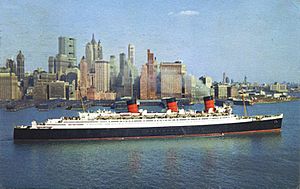
Cunard-White Star then started building a second "Queen" ship, the Queen Elizabeth. These two "Queens" became vital during the Second World War. They carried over two million soldiers across the oceans, helping to shorten the war.
After the war, in 1947, Cunard bought White Star's remaining share. By 1949, the company was simply called "Cunard Line" again.
The Age of Air Travel (1950–1968)
In the 1950s, Cunard was very successful, especially with its "Queens" carrying many passengers across the Atlantic. Their slogan was "Getting there is half the fun," focusing on the joy of the journey.
However, everything changed in 1958 with the introduction of jet airliners. Air travel became much faster and cheaper than sea travel. In 1960, more people crossed the Atlantic by air than by sea for the first time.
Cunard tried to adapt by getting into the airline business, even buying part of an airline called British Eagle. They hoped to offer both sea and air travel. But this didn't work out, and Cunard left the airline market by 1966.
By the late 1960s, most of the old Atlantic liners were retired. The Queen Mary and Queen Elizabeth both stopped service. Cunard decided to focus on cruises and summer transatlantic trips. They built a new ship, the Queen Elizabeth 2 (QE2), which was designed to do both. On November 4, 1968, the White Star Line flag was officially retired from Cunard ships.
New Owners and Modern Era (1971–Present)
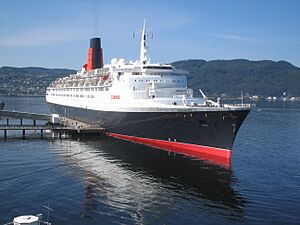
In 1971, a large company called Trafalgar House bought Cunard. At this time, Cunard had many cargo ships, passenger ships, and even hotels. Trafalgar House sold off most of the cargo ships to focus on passenger cruises.
During the Falklands War in 1982, the QE2 and Cunard Countess were used as troopships. Sadly, one of Cunard's cargo ships, the Atlantic Conveyor, was sunk during the conflict.
Cunard continued to grow its cruise business, buying other cruise lines and ships. However, by the mid-1990s, Cunard was facing problems and losing money.
In 1998, Carnival Corporation, a huge cruise company, bought Cunard. Carnival wanted to make Cunard a top luxury brand, focusing on its British history and elegant ocean travel. They introduced "White Star Service" on their ships, a nod to the high standards of the old White Star Line.
In 2004, the QE2 was replaced on the transatlantic route by the magnificent Queen Mary 2 (QM2), a true ocean liner. The QE2 continued cruising until she retired in 2008.
Cunard then added two new cruise ships, the Queen Victoria in 2007 and the Queen Elizabeth in 2010. In 2011, Cunard changed the registration of its ships to Bermuda. This allows captains to perform weddings at sea, which is popular for passengers.
On May 25, 2015, all three Cunard ships – Queen Mary 2, Queen Elizabeth, and Queen Victoria – sailed together into Liverpool to celebrate Cunard's 175th anniversary. It was a spectacular event!
In September 2017, Cunard announced plans for a fourth ship. This new ship, named Queen Anne, was delivered to Cunard on April 19, 2024. She arrived in Southampton on April 30, 2024, and began her first cruise on May 3, 2024. The Queen Anne was officially named in Liverpool on June 3, 2024.
In August 2023, Cunard made sure all its ships could use shore power when docked. This means they can plug into external electricity and turn off their engines, which is better for the environment.
The White Star Line flag is still raised on all current Cunard ships every April 15th to remember the Titanic disaster.
Cunard Hotels
After Trafalgar House bought Cunard in 1971, Cunard also managed hotels. They were called Cunard-Trafalgar Hotels and later Cunard Hotels & Resorts. This hotel business closed in 1995.
Current Fleet
Cunard currently operates four ships, known for their elegance and luxury.
| Ship | Delivered | In service for Cunard | Shipyard | Type | Gross tonnage | Flag | Christened By | Image |
|---|---|---|---|---|---|---|---|---|
| Queen Mary 2 | 2003 | 2004-present | Chantiers de l'Atlantique, St Nazaire, France | Ocean liner | 149,215 GT | Elizabeth II | 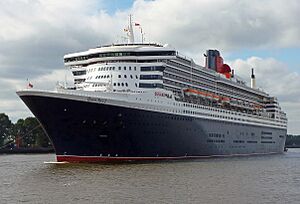 |
|
| Queen Victoria | 2007 | 2007–present | Fincantieri Marghera Shipyard, Italy | Cruise ship | 90,746 GT | Camilla, Duchess of Cornwall | 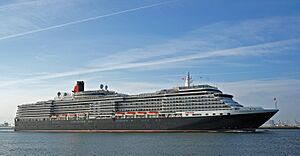 |
|
| Queen Elizabeth | 2010 | 2010–present | Fincantieri Monfalcone Shipyard, Italy | Cruise ship | 90,901 GT | Elizabeth II | ||
| Queen Anne | 2024 | 2024-present | Fincantieri Marghera Shipyard, Italy | Cruise ship | 114,188 GT | Ngunan Adamu, Natalie Haywood, Jayne Casey, Katarina Johnson-Thompson and Melanie C | 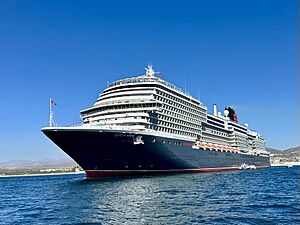 |
Images for kids
See also
 In Spanish: Cunard Line para niños
In Spanish: Cunard Line para niños
- Cunard Building (New York City)
- Cunard Yanks



